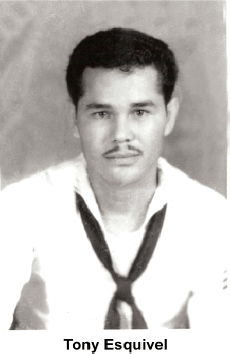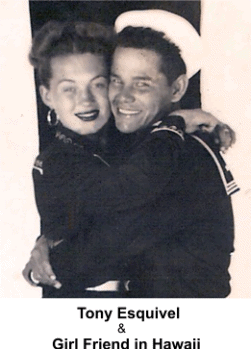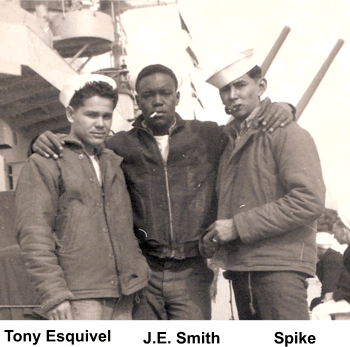Houstonian Escaped In Ship Explosion Seamen Tony Esquivel of Houston was on the cruiser St. Paul when an 8-inch gun turrent(sic) explosion killed 30 of his shipmates on April 21. But death was very close for Esquivel… only a moment or two away. Now that the censors have lifted the cloud of secrecy his story can be told. And he told it in a letter to his brother, E. M. Esquivel of 7331 Ave. K.
‘Just Lucky’
“Our division was just lucky I guess,” the 23-year-old sailor wrote. “We had just gotten out of there. It was just a matter of minutes.” Seaman Esquivel didn’t say where he was at the time of the blast which occurred while the battle-scarred cruiser was shelling the Korean coast; but he continued: “I was worried at first because I couldn’t find my buddy, Arthur. At the same time he was worried about me. I was really glad to see him out of danger. Will Never Forget “It was pretty bad, believe me; something that I will never forget. I have seen dead men before, but nothing like what happened here. These guys were burned to death.” Seaman Esquivel said no one knows how the explosion occurred because, “none of them lived to tell the story.” The sailor attended Edison Junior High School. He enlisted in 1948.


 [
[
The Houston Press
VOL. 1 NO. 184 HOUSTON, TEXAS, FRIDAY, APRIL 25, 1952 U. S. CRUISER BLAST! 30 DIE Turret Explodes Off Korea TOKYO. Saturday, April 26, –(UP)—An explosion in the forward turret of the U.S. heavy cruiser St. Paul killed 30 men Monday while the ship was firing on Communist targets in Korea, the Navy announced today. The explosion was not caused by enemy action. It was the heaviest casualty suffered by any U. S. ship in the Korean war. The previous high casualty list was 26, suffered when the destroyer Walke hit a mine near Wonsan June 12, 1951. Details were lacking. A Navy spokesman in Tokyo said a powder bag may have caused the fire, leading to a heavy explosion inside the turret. The explosion may have flashed down inside the turret’s armor to kill the men in the upper ammunition handling room. Every man within the vicinity of the explosion was killed, the Navy said. There were no wounded. (In Washington the Navy said notification of next of kin had been delayed slightly because of the Western Union strike. Notifications were sent by special delivery air mail instead of the customary telegram.) The St. Paul retired from the action only long enough to put the dead aboard the American hospital ship Haven, which steamed north from Pusan to the scene of the accident, just off Komo, a North Korean coastal town about halfway between the front battle lines and Wosan on the Sea of Japan. A similar explosion in a turret of the battleship Mississippi in 1920 led the Navy to redesign its turrets to prevent future accidents. Rear Adm. Earl E. Stone, commander of Cruiser Division One, who uses the St. Paul as his flagship, ordered an immediate investigation of the accident. The St. Paul’s commander, Capt. Roy A. Gano, Falls Church, VA. kept his ship in position and continued action against the Communists. The St. Paul is a 17,400-ton ship of the Baltimore class and is a veteran of World War II. Instead of being put into mothballs as were most of the heavier U.S. ships she continued on active duty on the China station. She is now on her second tour of duty in Korean waters, having arrived back from the States on Nov. 21, 1951. Her wartime complement is 1700 officers and men.